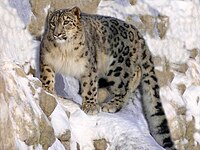
Photo from wikipedia
Abstract Predicting the likelihood of wildlife presence at potential wildlife–livestock interfaces is challenging. These interfaces are usually relatively small geographical areas where landscapes show large variation over small distances. Models… Click to show full abstract
Abstract Predicting the likelihood of wildlife presence at potential wildlife–livestock interfaces is challenging. These interfaces are usually relatively small geographical areas where landscapes show large variation over small distances. Models of wildlife distribution based on coarse data over wide geographical ranges may not be representative of these interfaces. High‐resolution data can help identify fine‐scale predictors of wildlife habitat use at a local scale and provide more accurate predictions of species habitat use. These data may be used to inform knowledge of interface risks, such as disease transmission between wildlife and livestock, or human–wildlife conflict. This study uses fine‐scale habitat use data from wild boar (Sus scrofa) based on activity signs and direct field observations in and around the Forest of Dean in Gloucestershire, England. Spatial logistic regression models fitted using a variant of penalized quasi‐likelihood were used to identify habitat‐based and anthropogenic predictors of wild boar signs. Our models showed that within the Forest of Dean, wild boar signs were more likely to be seen in spring, in forest‐type habitats, closer to the center of the forest and near litter bins. In the area surrounding the Forest of Dean, wild boar signs were more likely to be seen in forest‐type habitats and near recreational parks and less likely to be seen near livestock. This approach shows that wild boar habitat use can be predicted using fine‐scale data over comparatively small areas and in human‐dominated landscapes, while taking account of the spatial correlation from other nearby fine‐scale data‐points. The methods we use could be applied to map habitat use of other wildlife species in similar landscapes, or of movement‐restricted, isolated, or fragmented wildlife populations.
Journal Title: Ecology and Evolution
Year Published: 2022
Link to full text (if available)
Share on Social Media: Sign Up to like & get
recommendations!